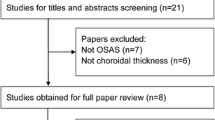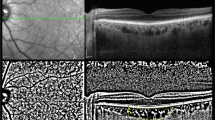Abstract
Purpose
The purpose of this study is to assess macular choroidal thickness measurements in patients with different severities of obstructive sleep apnea syndrome (OSAS) versus normal controls by using enhanced depth imaging optical coherence tomography (EDI-OCT).
Design
This paper is a descriptive study.
Materials and methods
In this prospective study, the macular area of 74 patients with OSAS and 33 controls were evaluated. All subjects underwent complete ophthalmic examination and macular choroidal thickness (CT) measurements by enhanced depth imaging method of the Spectralis optical coherence tomography system. Choroidal thickness (CT) was measured at the fovea and at 1,000-μm intervals from the foveal center in both temporal and nasal directions by two masked observers.
Results
The mean age was not significantly different between patients with OSAS and controls. Patients were grouped as mild (n = 15), moderate (n = 28), and severe (n = 31) according to apnea-hypopnea index (AHI) scores. The mean subfoveal choroidal thickness (SFCT) was 338.0 ± 85.2 μm in the control group versus 351.3 ± 90, 307.8 ± 65.5, and 325.4 ± 110.2 μm in mild, moderate, and severe groups, respectively (p = 0.416). There was no significant correlation between the severity of OSAS and choroidal thickness.
Conclusions
The patients with OSAS seem to protect the choroidal thickness despite hypoxia. The role of OSAS in the pathophysiology of choroidal blood flow and choroidal structure needs further investigation.

Similar content being viewed by others
References
Bradley TD, Floras JS (2003) Sleep apnea and heart failure: part I: obstructive sleep apnea. Circulation 107(12):1671–1678
Hayreh SS, Zimmerman MB, Podhajsky P, Alward WL (1994) Nocturnal arterial hypotension and its role in optic nerve head and ocular ischemic disorders. Am J Ophthalmol 117(5):603–624
Chervin RD, Guilleminault C (1996) Obstructive sleep apnea and related disorders. Neurol Clin 14(3):583–609
Kergoat H, Marinier JA, Lovasik JV (2005) Effects of transient mild systemic hypoxia on the pulsatile choroidal blood flow in healthy young human adults. Curr Eye Res 30(6):465–470
Lange CA, Bainbridge JW (2012) Oxygen sensing in retinal health and disease. Ophthalmologica 227(3):115–131
Robinson F, Riva CE, Grunwald JE, Petrig BL, Sinclair SH (1986) Retinal blood flow autoregulation in response to an acute increase in blood pressure. Invest Ophthalmol Vis Sci 27(5):722–726
Lovasik JV, Kergoat H, Riva CE, Petrig BL, Geiser M (2003) Choroidal blood flow during exercise-induced changes in the ocular perfusion pressure. Invest Ophthalmol Vis Sci 44(5):2126–2132
Vujosevic S, Martini F, Cavarzeran F, Pilotto E, Midena E (2012) Macular and peripapillary choroidal thickness in diabetic patients. Retina 32(9):1781–1790
Spaide RF, Koizumi H, Pozzoni MC (2008) Enhanced depth imaging spectral-domain optical coherence tomography. Am J Ophthalmol 146(4):496–500
Karaca EE, Ozdek S, Yalcin NG, Ekici F (2014) Reproducibility of choroidal thickness measurements in healthy Turkish subjects. Eur J Ophthalmol 24(2):202–208
Ding X, Li J, Zeng J, Ma W, Liu R, Li T et al (2011) Choroidal thickness in healthy Chinese subjects. Invest Ophthalmol Vis Sci 52(13):9555–9560
Fujiwara A, Shiragami C, Shirakata Y, Manabe S, Izumibata S, Shiraga F (2012) Enhanced depth imaging spectral-domain optical coherence tomography of subfoveal choroidal thickness in normal Japanese eyes. Jpn J Ophthalmol 56(3):230–235
Coskun E, Gurler B, Pehlivan Y, Kisacik B, Okumus S, Yayuspayi R et al (2013) Enhanced depth imaging optical coherence tomography findings in Behcet disease. Ocul Immunol Inflamm 21(6):440–445
Dhoot DS, Huo S, Yuan A, Xu D, Srivistava S, Ehlers JP et al (2013) Evaluation of choroidal thickness in retinitis pigmentosa using enhanced depth imaging optical coherence tomography. Br J Ophthalmol 97(1):66–69
Dhillon S, Shapiro CM, Flanagan J (2007) Sleep-disordered breathing and effects on ocular health. Can J Ophthalmol 42(2):238–243
Crofts HS, Wilson S, Muggleton NG, Nutt DJ, Scott EA, Pearce PC (2001) Investigation of the sleep electrocorticogram of the common marmoset (Callithrix jacchus) using radiotelemetry. Clin Neurophysiol 112(12):2265–2273
Quan S, Gillin JC, Littner M, Shepard J (1999) Sleep-related breathing disorders in adults: recommendations for syndrome definition and measurement techniques in clinical research. Editorials. Sleep 22(5):662–689
Ikuno Y, Maruko I, Yasuno Y, Miura M, Sekiryu T, Nishida K et al (2011) Reproducibility of retinal and choroidal thickness measurements in enhanced depth imaging and high-penetration optical coherence tomography. Invest Ophthalmol Vis Sci 52(8):5536–5540
Hermida RC, Smolensky MH, Ayala DE et al (2013) Ambulatory blood pressure monitoring recommendations for the diagnosis of adult hypertension, assessment of cardiovascular and other hypertension-associated risk, and attainment of therapeutic goals [summary]. Joint recommendations from the International Society for Chronobiology [ISC], American Association of Medical Chronobiology and Chronotherapeutics [AAMCC], Spanish Society of Applied Chronobiology, Chronotherapy, and Vascular Risk [SECAC], Spanish Society of Atherosclerosis [SEA], and Romanian Society of Internal Medicine [RSIM]. Clin Investig Arterioscler 25(2):74–82
Vijayan VK (2012) Morbidities associated with obstructive sleep apnea. Expert Rev Respir Med 6(5):557–566
Wangsa-Wirawan ND, Linsenmeier RA (2003) Retinal oxygen: fundamental and clinical aspects. Arch Ophthalmol 121(4):547–557
Vanderkooi JM, Erecinska M, Silver IA (1991) Oxygen in mammalian tissue: methods of measurement and affinities of various reactions. Am J Physiol 260(6 Pt 1):C1131–C1150
Kergoat H, Herard ME, Lemay M (2006) RGC sensitivity to mild systemic hypoxia. Invest Ophthalmol Vis Sci 47(12):5423–5427
Deutsch TA, Read JS, Ernest JT, Goldstick TK (1983) Effects of oxygen and carbon dioxide on the retinal vasculature in humans. Arch Ophthalmol 101(8):1278–1280
Fallon TJ, Maxwell D, Kohner EM (1985) Retinal vascular autoregulation in conditions of hyperoxia and hypoxia using the blue field entoptic phenomenon. Ophthalmology 92(5):701–705
Pakola SJ, Grunwald JE (1993) Effects of oxygen and carbon dioxide on human retinal circulation. Invest Ophthalmol Vis Sci 34(10):2866–2870
Kergoat H, Faucher C (1999) Effects of oxygen and carbogen breathing on choroidal hemodynamics in humans. Invest Ophthalmol Vis Sci 40(12):2906–2911
Bill A, Sperber GO (1990) Control of retinal and choroidal blood flow. Eye (Lond) 4(Pt 2):319–325
Bill A, Nilsson SF (1985) Control of ocular blood flow. J Cardiovasc Pharmacol 7(Suppl 3):S96–S102
Riva CE, Cranstoun SD, Grunwald JE, Petrig BL (1994) Choroidal blood flow in the foveal region of the human ocular fundus. Invest Ophthalmol Vis Sci 35(13):4273–4281
Schmetterer L, Wolzt M, Lexer F, Alschinger C, Gouya G, Zanaschka G et al (1995) The effect of hyperoxia and hypercapnia on fundus pulsations in the macular and optic disc region in healthy young men. Exp Eye Res 61(6):685–690
Schmetterer L, Lexer F, Findl O, Graselli U, Eichler HG, Wolzt M (1996) The effect of inhalation of different mixtures of O2 and CO2 on ocular fundus pulsations. Exp Eye Res 63(4):351–355
Xin C, Wang J, Zhang W, Wang L, Peng X (2014) Retinal and choroidal thickness evaluation by SD-OCT in adults with obstructive sleep apnea-hypopnea syndrome (OSAS). Eye [Lond]. doi:10.1038/eye.2013.307
Stone RA, Kuwayama Y, Laties AM (1987) Regulatory peptides in the eye. Experientia 43(7):791–800
Shiragami C, Shiraga F, Matsuo T, Tsuchida Y, Ohtsuki H (2002) Risk factors for diabetic choroidopathy in patients with diabetic retinopathy. Graefes Arch Clin Exp Ophthalmol 240(6):436–442
Imamura Y, Fujiwara T, Margolis R, Spaide RF (2009) Enhanced depth imaging optical coherence tomography of the choroid in central serous chorioretinopathy. Retina 29(10):1469–1473
Masuda R, Isoyama T, Bandou T, Toyoshima H, Takemura T (1990) A primary choriocarcinoma of the stomach with a review of 45 cases in Japan. Gan No Rinsho 36(9):1025–1030
Ogasawara M, Maruko I, Sugano Y, Ojima A, Sekiryu T, Iida T (2012) Retinal and choroidal thickness changes following intravitreal ranibizumab injection for exudative age-related macular degeneration. Nihon Ganka Gakkai Zasshi 116(7):643–649
Maruko I, Iida T, Sugano Y, Ojima A, Sekiryu T (2011) Subfoveal choroidal thickness in fellow eyes of patients with central serous chorioretinopathy. Retina 31(8):1603–1608
Maruko I, Iida T, Sugano Y, Oyamada H, Sekiryu T, Fujiwara T et al (2011) Subfoveal choroidal thickness after treatment of Vogt-Koyanagi-Harada disease. Retina 31(3):510–517
Nishida Y, Fujiwara T, Imamura Y, Lima LH, Kurosaka D, Spaide RF (2012) Choroidal thickness and visual acuity in highly myopic eyes. Retina 32(7):1229–1236
Margolis R, Spaide RF (2009) A pilot study of enhanced depth imaging optical coherence tomography of the choroid in normal eyes. Am J Ophthalmol 147(5):811–815
Manjunath V, Taha M, Fujimoto JG, Duker JS (2010) Choroidal thickness in normal eyes measured using Cirrus HD optical coherence tomography. Am J Ophthalmol 150(3):325–9 e1
Yamashita T, Shirasawa M, Arimura N, Terasaki H, Sakamoto T (2012) Repeatability and reproducibility of subfoveal choroidal thickness in normal eyes of Japanese using different SD-OCT devices. Invest Ophthalmol Vis Sci 53(3):1102–1107
Benavente-Perez A, Hosking SL, Logan NS, Bansal D (2010) Reproducibility-repeatability of choroidal thickness calculation using optical coherence tomography. Optom Vis Sci 87(11):867–872
Conflict of interest
The authors report no potential conflict of interest relevant to this article.
Author information
Authors and Affiliations
Corresponding author
Rights and permissions
About this article
Cite this article
Karaca, E.E., Ekici, F., Yalçın, N.G. et al. Macular choroidal thickness measurements in patients with obstructive sleep apnea syndrome. Sleep Breath 19, 335–341 (2015). https://doi.org/10.1007/s11325-014-1025-6
Received:
Revised:
Accepted:
Published:
Issue Date:
DOI: https://doi.org/10.1007/s11325-014-1025-6




